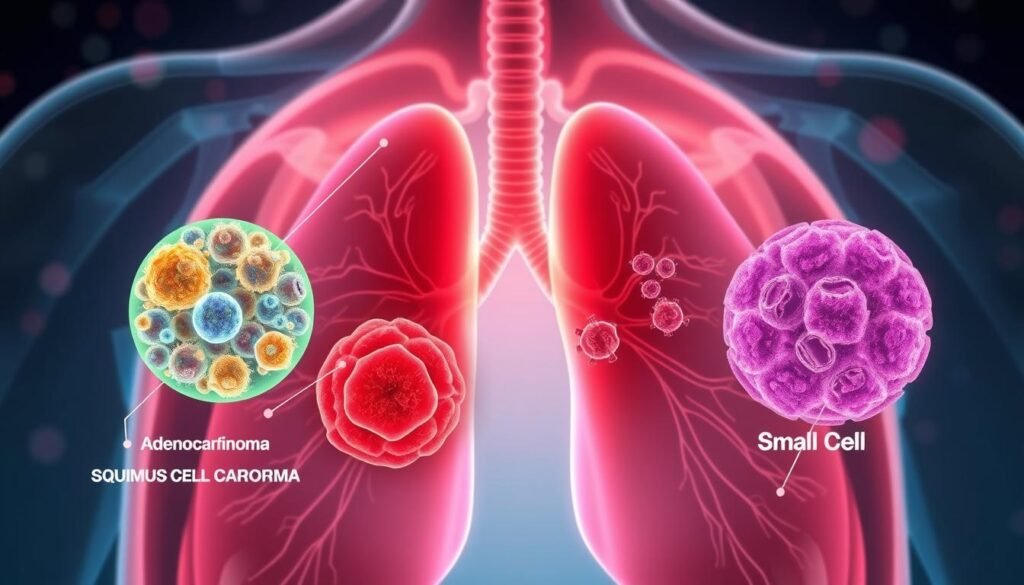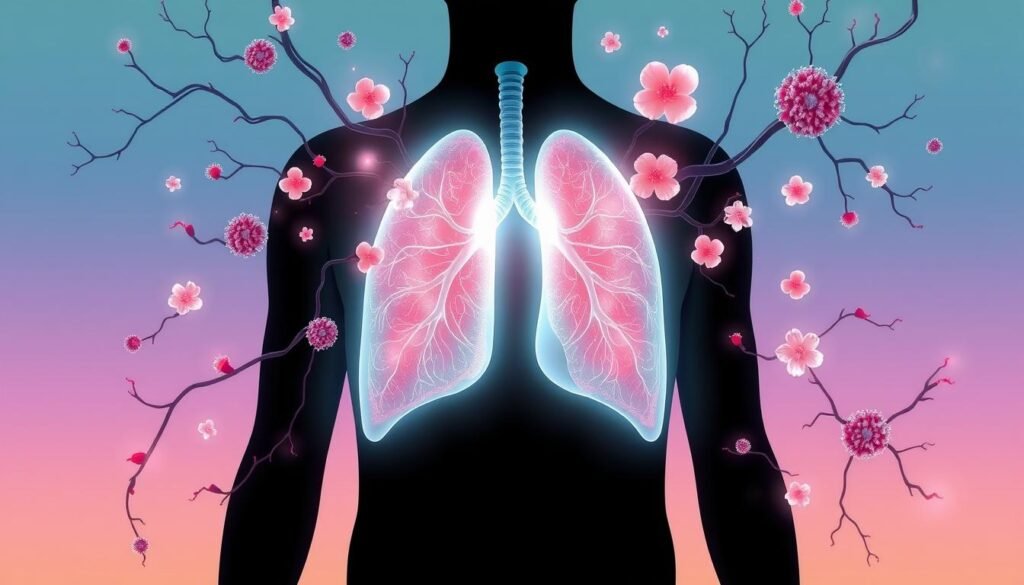The overall five-year survival rate for stage 3 lung cancer is about 19.75%. This highlights the seriousness of this advanced stage. At this point, cancer often extends to nearby lymph nodes or structures. This makes treatment more complex and affects life expectancy.
The survival rate for stage 3A non-small cell lung cancer changes widely. It’s 64% if cancer stays in the lung but drops to 8% if it spreads far. Thanks to advances in science, new treatments are helping improve patients’ lives.
Looking at survival rates might scare patients and their loved ones. Yet, knowing what to expect helps them make better choices about care. This piece gives vital info on life expectancy, treatment effects, and coping with stage 3 lung cancer.
Key Takeaways
- Stage 3 lung cancer presents a significant challenge, with an overall five-year survival rate of approximately 19.75%.
- Survival rates vary significantly between subtypes, particularly between non-small cell and small cell lung cancers.
- Understanding prognosis helps patients make informed decisions about treatment options.
- A range of 64% to 8% survival can occur depending on whether the cancer is localized or has spread.
- Advancements in treatment significantly impact life expectancy and quality of life.
- Age and overall health play critical roles in determining individual life expectancy in stage 3 lung cancer.
Understanding Stage 3 Lung Cancer
Stage 3 lung cancer is a crucial phase in the journey, marked by cancer’s spread nearby, especially to lymph nodes. It’s split into 3a, 3b, and 3c, each with its struggles relating to treatments and outcomes. Knowing these differences helps in tackling the disease.
For stage 3a patients, surgery might be an option, bringing some hope. However, stages 3b and 3c show a more severe spread, calling for different treatment plans. The tumor’s size and how far it’s spread, together with a patient’s health, guide the treatment path.
- Stage 3a: Potential for surgery and a better prognosis.
- Stage 3b: Typically requires a combination of chemotherapy and radiotherapy.
- Stage 3c: Less favorable prognosis, often limited treatment options.
Knowing about stage 3 lung cancer helps patients and families get ready for what’s ahead. Discussing prognosis and treatment options with healthcare professionals is key in this tough time.
Defining the Stages of Lung Cancer
The TNM classification system is used to determine lung cancer stages. It looks at the tumor size (T), if cancer has reached lymph nodes (N), and if it’s spread to distant organs (M). This assessment is key for deciding on treatments and predicting outcomes. Stage 3 is when the cancer has spread more, which is a big jump from earlier stages.
It’s important to know the differences in lung cancer stages, particularly stage 3. This stage splits into 3A, 3B, and 3C, each with its own traits. Stage 3A means tumors are between 3 cm to 7 cm. They might have spread to nearby tissues or lymph nodes. Stage 3B includes bigger tumors or those that have reached close structures or lymph nodes. Stage 3C involves tumors that have moved to various locations in the body.
Survival rates for these stages give valuable insight into what to expect. For non-small cell lung cancer (NSCLC), stage 3 has about a 37% chance of survival for five years. Small cell lung cancer (SCLC) has a rough 18% five-year survival rate. These figures are based on cases from 2012 to 2018 and could be higher now due to medical advances.
| Lung Cancer Stage | Type of Cancer | 5-Year Relative Survival Rate |
|---|---|---|
| Stage 3A | NSCLC | 37% |
| Stage 3B | NSCLC | Varies |
| Stage 3C | NSCLC | Varies |
| Stage 3 (overall) | SCLC | 18% |
Knowing about lung cancer stages and predictions helps patients and families understand treatments. It also helps them know how it affects survival and life quality.
How Long Can You Live with Stage 3 Lung Cancer
When talking about stage 3 lung cancer, it’s vital to look at survival rates. Also, we must consider what affects how long patients can live. This stage has different types, like non-small cell lung cancer (NSCLC). It’s split into stages 3A, 3B, and 3C. Each one has its own prognosis. Understanding a patient’s health profile helps predict their outcome.
Survival Rates Overview
Survival rates for lung and bronchus cancer vary greatly. It depends on the cancer stage. Here are some stats:
| Stage | Five-Year Survival Rate |
|---|---|
| Localized | 62.8% |
| Regional | 34.8% |
| Distant | 8% |
| Stage 3 NSCLC (overall) | Approx. 25.4% |
For stage 3A, the survival rate is around 36%. It drops to 13% for stage 3C. Treatment can extend life. Chemotherapy, for instance, might offer an average of 29 months. Immunotherapy might give up to 47.5 months. Starting treatment early can greatly improve survival rates.
Factors Influencing Life Expectancy
Life expectancy with stage 3 lung cancer is not just about cancer stage. Other factors are also important. They include:
- Age—Younger people often fare better.
- Sex—Survival can vary between genders.
- Overall health—Existing health conditions can affect outcomes.
- Lifestyle choices—Survival rates are better for non-smokers.
Genetic factors and personal habits also matter a lot. Seeing a healthcare provider for a full review is key. They can explain how these factors impact life expectancy and prognosis. For more details on stage 3 lung cancer, check out this in-depth article: understanding life expectancy and treatment implications.
Types of Lung Cancer and Their Impact on Prognosis
Lung cancer comes in two main forms: non-small cell lung cancer (NSCLC) and small cell lung cancer (SCLC). NSCLC accounts for about 80–85% of all cases, while SCLC makes up 10–15%. Knowing the type of lung cancer is key for the prognosis and treatment choices for patients.
NSCLC is split into several subtypes like lung adenocarcinoma, squamous cell carcinoma, and large cell carcinoma. Each one acts differently and needs specific therapy. Local NSCLC has a five-year survival rate of about 65%. But SCLC, being more aggressive, has a survival rate of only 30% at the same stage.
As the cancer grows, the prognosis gets worse. For regional NSCLC, survival drops to 37% over five years. SCLC patients see only an 18% chance. When cancer spreads far, NSCLC patients have a 9% five-year survival rate. SCLC patients have an even lower chance at 3%. Catching the cancer early is crucial for better results. Knowing the first signs of lung cancer can help with early detection. Recognizing these symptoms early on is important
Getting diagnosed and starting treatment early is not just about the type of lung cancer. Guidelines now recommend yearly screenings for those 50–80 years old who have smoked a lot. These screenings could cut lung cancer deaths by 20%. New treatments offer more hope than before to those fighting lung cancer.

Current Treatment Options for Stage 3 Lung Cancer
Treatment for stage 3 lung cancer includes many approaches. The type of cancer and patient health guide the choice. Surgery, chemotherapy, and new therapies are among the options.
Surgery and Its Role
For those with stage 3A non-small cell lung cancer, surgery might be possible. This is likely if cancer shrinks after treatments like chemoradiation. Despite its benefits, surgery carries a recurrence risk.
Thus, it requires a careful decision-making process.
Chemotherapy and Radiotherapy
Chemotherapy is key in treating stage 3 lung cancer. It uses drugs like cisplatin with etoposide or gemcitabine. Chemotherapy works before and after surgery. Additionally, external radiation may be the primary treatment when surgery isn’t an option. These methods aim to raise survival rates and shrink the tumor.
Emerging Treatments and Clinical Trials
New treatment ideas are on the rise. Targeted therapies are growing in significance. These therapies hinge on the genetic makeup of the cancer. Erlotinib, gefitinib, and osimertinib treat EGFR-positive stage 3 non-small cell lung cancer. Similarly, immunotherapies like durvalumab and cemiplimab are promising. Clinical trials could provide access to these innovative treatments. They play a crucial role in enhancing lung cancer care.
Understanding Metastatic Lung Cancer
Metastatic lung cancer marks a severe stage, where cancer cells spread from the lungs to other body parts. This makes treating the disease harder and affects how long patients can live. Knowing about this lung cancer type is vital for those dealing with it, as it poses special challenges to their health.
About one-third of people with lung cancer will face this advanced stage. This stage of lung cancer often means lower chances of surviving, because the cancer has spread too much. For instance, only about 8% of people with metastatic non-small cell lung cancer might live more than five years. And for small cell lung cancer, the number drops to 3% at this stage.
When cancer spreads, symptoms like losing weight, feeling very tired, and having trouble breathing can occur. Dealing with these means using many treatments like chemotherapy, targeted therapy, and care to improve comfort. It’s crucial for patients to talk with their doctors about their options. This helps create a care plan that suits them best and improves their life.
Below is a comparison of survival rates based on the cancer type and stage:
| Cancer Type | Stage | 5-Year Survival Rate |
|---|---|---|
| Non-Small Cell Lung Cancer (NSCLC) | Localized | 60% |
| Non-Small Cell Lung Cancer (NSCLC) | Regional | 33% |
| Non-Small Cell Lung Cancer (NSCLC) | Distant (Metastatic) | 8% |
| Small Cell Lung Cancer (SCLC) | Localized | 29% |
| Small Cell Lung Cancer (SCLC) | Regional | 15% |
| Small Cell Lung Cancer (SCLC) | Distant (Metastatic) | 3% |
Starting treatment early and managing symptoms well are key to living longer with metastatic lung cancer. Having open talks with doctors lets patients better handle this tough situation.

Coping with Kidney Metastases
Finding out about lung cancer is scary, especially when it spreads to organs like the kidneys. The movement of cancer from the lungs to the kidneys is serious. It affects health deeply and changes how long patients may live. Knowing about this spread is key for those who are sick and their caregivers.
How Lung Cancer Can Spread to the Kidneys
Lung cancer can move to the kidneys via blood or lymph fluids. This spread can happen, even when the lung tumor hasn’t grown much. When cancer cells reach the kidneys, they can harm how the kidneys work. This hurt can make the patient’s health worse. Spotting signs that the kidneys are affected is very important.
Life Expectancy with Kidney Metastases
Life expectancy after lung cancer moves to the kidneys is a big worry. Once it has spread to the kidneys, the chance of living five more years gets much lower. Only 17% of people in this situation live five years or more. This fact shows how crucial good treatments and support are. Things like how well treatment works, overall health, and age matter a lot in survival chances.
Talking about what treatments are possible is something doctors focus on. They also talk about care that makes patients more comfortable, despite the cancer. These steps are about making life better for patients, knowing how serious the illness is.
Palliative Care and Quality of Life
Palliative care is key in treating lung cancer, especially stage 3. It focuses on improving life quality, not just fighting the disease. Patients get help with symptoms, emotional support, and personalized care. Palliative care can start early, even before severe symptoms appear, to support patients fully.
A team of experts, including doctors, nurses, and social workers, provide palliative care. They work together to address both physical and emotional needs. This teamwork improves communication about treatments. It creates a supportive space for patients and their families.
Studies show early palliative care leads to better patient outcomes. Those with early support lived about 11.6 months, longer than those who didn’t, who lived around 8.9 months. This proves palliative care not only comforts but may also extend lives in hard times.

Palliative care covers many treatments, from pain management to psychological support. This broad approach helps ensure a life of dignity and quality. It’s especially important at life’s end. As patients deal with lung cancer, palliative care gives crucial help and relief. For more about palliative care, visit this resource.
Disease Management Strategies
Managing stage 3 lung cancer requires teamwork. Different treatments and supportive care are combined. It’s key that patients talk openly with their cancer care team. This ensures the treatment plan fits their personal needs.
Making lifestyle changes is also important. Staying active, eating well, and keeping hydrated can greatly improve quality of life. Joining programs that encourage exercise can help with symptoms. It can also boost mood and make treatment easier.
It’s vital not to ignore nutritional needs. Eating right helps with recovery and managing therapy side effects. Oncology dietitians can create meal plans that really help.
Emotional support is just as crucial. Counselors offer strategies to deal with lung cancer’s emotional toll. This boosts life quality during treatment.
Keeping up with regular check-ups is essential. They help track progress and tweak treatments if needed. Clinical trials may also be an option. They offer new treatments for patients who need something different.
Teaching patients about their disease and treatments helps greatly. It leads to better care through teamwork and shared choices. This approach not only manages symptoms better but also improves the treatment journey.
| Strategy | Description | Benefits |
|---|---|---|
| Regular Follow-ups | Consistent communication with oncologists to assess treatment efficacy. | Allows timely adjustments to treatment plans. |
| Nutritional Support | Guided meal planning by oncology dietitians. | Enhances recovery and mitigates treatment side effects. |
| Psychological Counseling | Access to mental health professionals for emotional support. | Improves coping mechanisms and emotional well-being. |
| Physical Activity | Engagement in structured exercise programs. | Boosts mood, alleviates symptoms, and improves treatment response. |
| Participation in Clinical Trials | Exploring novel treatment options available through research studies. | Access to cutting-edge therapies that may improve outcomes. |
In short, a well-rounded approach is key to lung cancer care. It makes sure patients get the best care suited to their specific situation.
Conclusion
Understanding stage 3 lung cancer is key for patients and their families. They face big challenges with life expectancy and treatment choices. This cancer stage can be hard to grasp, but new treatments have brought hope. For example, getting chemo before surgery has helped some people live longer than the traditional chemo and radiation approach. It’s crucial to make informed decisions.
Statistics show a wide range in survival rates for stage IIIA lung cancer. They go from as low as 2% to as high as 15% with the right treatment. Patients who opt for surgery usually have a better outlook. They are often younger and have less severe disease, living an average of 20.8 months with various therapies. This shows why planning the right treatment for each person is so important.
Battling stage 3 lung cancer involves more than just medical care. It also means taking care of one’s emotional needs and getting support. Working closely with doctors, using all available resources, and staying strong can make a big difference in life quality and how long patients live. By keeping hope alive and getting complete care, patients can face this tough time with more confidence and dignity.